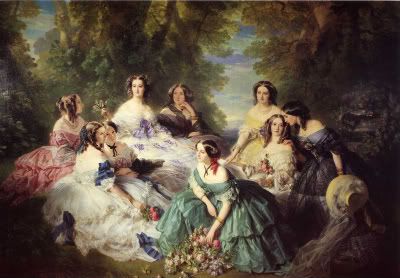
Portrait of the Empress Eugenie Surrounded by her Maids of Honor (1855) by Franz Xaver Winterhalter
Hair was parted in the center and drawn down over the ears and back into a bun or more decorative updo. Thick ringlets could frame the side of the face if the lady so chose. Flowers and ribbons were often put into the style as decoration.
The first layer of clothing worn would be a chemise. Since it was the closest to the body, it would be made of a simple fabric that could survive multiple washings. The chemise had short sleeves and a wide, low neckline.
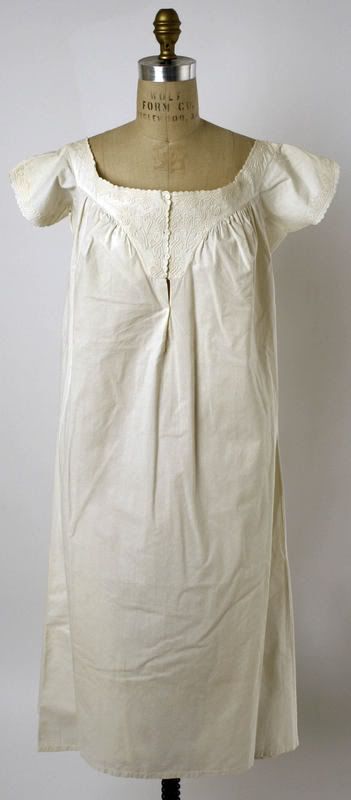
In addition to the chemise, the other closest garment to the body was a pair of drawers. Drawers were bifurcated garments that went to just below the knee, and were open at the crotch to make it easier for the lady to go to the bathroom. Because when you're wearing a million layers of skirts and a boned corset, trying to bend over to pull a garment with a crotch down and back up again is an enormous pain and quite difficult.

Next up would be a corset, which was meant to create an hourglass figure. Corsets laced up the back and hooked closed down the center front. The hourglass shape was created by both gussets and shaped pieces.
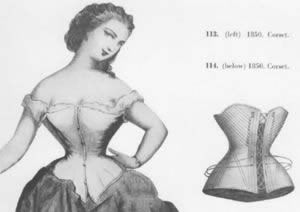
The shape of the skirt was given by a very newfangled invention called the cage crinoline. Before the crinoline, skirts were shaped by layers and layers of stiffened petticoats, which could get extremely heavy. The invention of the cage crinoline removed the need for all of these heavy and hot petticoats, thus was embraced by ladies everywhere. Men were not as thrilled. How are you supposed to get close to a lady and impress her with your gallant mustache if she is surrounded by wide hoops of metal? Of course the satirists had a field day. Field decade and a half to be exact, as the crinoline stayed in style until the end of the 1860s when it began to transform into a bustle. Punch magazine satirized the new fad in 1856, saying:
"Crinolineomania may be said to be essentially a female complaint, although many of the other sex- husbands in particular- are continually complaining of it... That Crinolineomania is of foreign origin Dr. Punch considers there is little room for doubt; indeed, if he were called upon to fix the spot precisely where the malady broke out, without hesitation he would point to Paris. Dr. Punch has ample grounds for his belief that the persons first affected were the ladies attached to the Imperial Court; and it is a more than mere surmise with him, that symptoms of the mania were primarily betrayed by the young and lovely Empress."
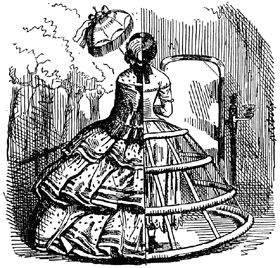
Illustration from an August 1856 issue of Punch magazine.
On top of the crinoline would be a petticoat or two, which would add extra fullness as well as hide any unsightly bumps caused by the hoops.
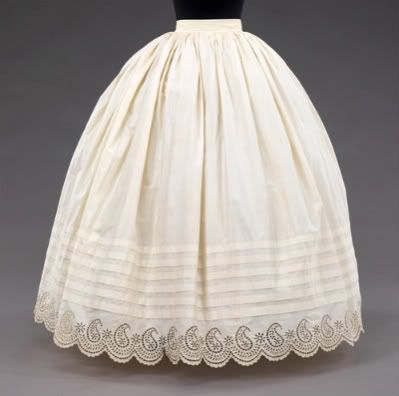
From the Metropolitan Museum of Art
Once you have been safely stored away under layers of steel and cloth, it's time to put on a garment that people will actually get to see. The bodice of the dress would have a wide, low neckline, exposing the shoulders. Sleeves were short, and the waistline dipped into a narrow V shape. The decoration around the neckline was called a bertha, and could be made of lace, tulle, or fabric from the dress itself. Under the bertha would be a tucker, a simple strip of white fabric which was attached to the neckline to provide some extra modesty and probably help preserve the expensive fabric of the bodice from damaging body oils. Skirts were knife pleated for extra fullness, and either pleated directly to the bodice or to a waistband which was then tacked onto the bodice. Extremely popular among fashionable ladies was a flounced skirt. Three wide flounces were common, as well as six or seven narrow ones. Dresses were decorated with all sorts of pretty things. Lace, fringe, ribbons, and false flowers in particular were popular.

From the Hungarian Digital Image Library
Legs were covered in white stockings, and to finish the ensemble were slippers.
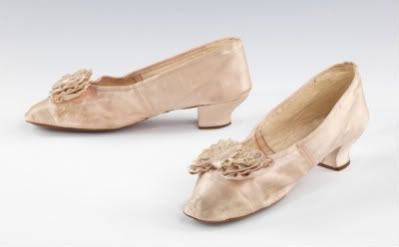
From the Metropolitan Museum of Art